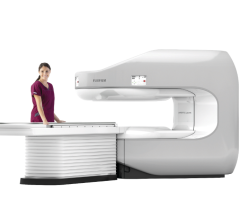
Discovery IQ PET/CT image courtesy of GE Healthcare
November 16, 2015 — GE Healthcare’s Molecular Imaging business will showcase the Discovery IQ positron emission tomography/computed tomography (PET/CT) platform at this year’s Radiological Society of North America (RSNA) annual meeting, delivering both outstanding image quality and intelligent quantitation. According to the company, Discovery IQ delivers the highest NEMA (National Electrical Manufacturers Association) sensitivity (up to 22 cps/kBq), the largest axial field-of-view (up to 26 cm) and the highest clinical NECR (Noise-Equivalent-Count-Rate) in the industry. Discovery IQ can image with both half the PET dose and half the scan time.
GE Healthcare’s new Q.Clear technology is a critical component of Discovery IQ. It delivers, for the first time, no trade-off between image quality and quantitative standardized uptake value (SUV) measurements. By providing two times improvement in both quantitative accuracy (SUVmean) and image quality (signal-to-noise ratio) in PET/CT imaging, this tool provides benefits to physicians across the cancer care continuum from diagnosis and staging disease to treatment planning and assessment.
GE will also be showcasing the Discovery NM/CT 670 Pro, which brings cutting-edge CT technology to nuclear medicine by now integrating with GE’s Optima CT540. It combines 50-slice equivalent CT speed for extended fast coverage of time-critical scans with advanced CT applications; dose management tools such as OptiDose, DoseWatch and ASiR; and a streamlined workflow for challenging stand-alone CT procedures.
Discovery NM/CT 670 Pro also features GE’s Q.Suite for single photon emission computed tomography (SPECT)/CT technologies. Two elements of Q.Suite for SPECT/CT are Q.AC and GE’s newest software innovation in nuclear medicine, Q.Metrix. Q.Metrix, a user-friendly application for measuring and reporting standard uptake values in the organ or lesion of interest, enables personalized, quantitative SPECT SUV results with multi-dimensional organ and lesion characterization. Q.AC is an image reconstruction technique designed to help improve accuracy of SPECT attenuation correction that enables quantitative SPECT measurements even at very low dose.
For more information: www.gehealthcare.com


 July 30, 2024
July 30, 2024 








